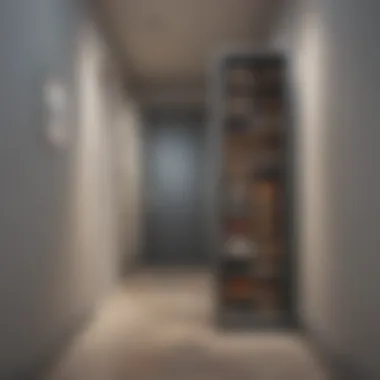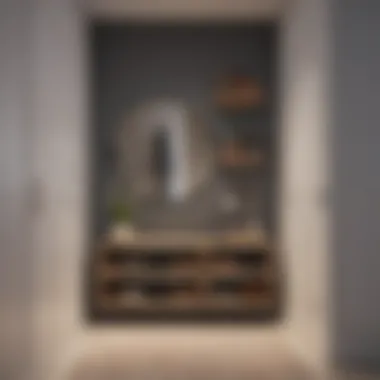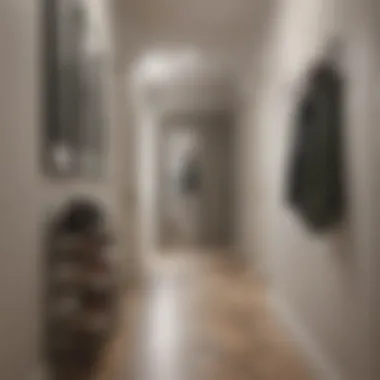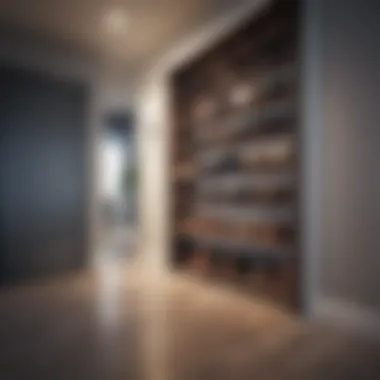Maximize Space: Shoe Storage for Narrow Hallways


Intro
The emphasis will be on innovative and stylish approaches that maximize limited space while ensuring that accessibility and organization remain at the forefront. Solutions range from specific furniture choices to design elements that enhance the overall atmosphere of the hallway. Readers will find actionable advice that can seamlessly integrate into their existing decor styles, ensuring that even the most compact areas can remain orderly and inviting.
Design Inspiration
Current Trends in Interior Design
When considering shoe storage in a narrow hallway, it is essential to stay informed about current interior design trends. These trends can guide the selection of furniture, colors, and overall design direction.
Minimalism is a prevalent trend. This involves simplifying spaces by using sleek, functional storage units that permit easy access and declutter the entryway. Items like narrow console tables with built-in shoe racks can fit seamlessly in a limited space. Selecting multi-functional furniture — for example, a bench that doubles as storage — maximizes utility without overwhelming the area.
Another trend is sustainable and eco-friendly design. Using materials from recycled sources or sustainably harvested wood can add an engaging story to your storage solutions. Creating a space that reflects personal values about sustainability can be profoundly rewarding.
Color Schemes and Palette Ideas
Selecting the right color palette is vital. It can create an illusion of space, which is particularly beneficial in narrow hallways.
- Light colors such as whites, soft grays, and pastels can visually expand the area, making it appear more open.
- Accent colors can be incorporated through accessories or a single statement piece. This adds a pop of personality without overwhelming the senses.
- Natural materials like wood can be left in their organic state or painted in light hues to maintain a sense of space while adding texture.
"The right color can turn storage from a mundane necessity into a stylish element of your home."
Using a strategic color scheme can also harmonize different elements in the hallway, tying together furniture, flooring, and wall colors into a cohesive look. This attention to detail is crucial for creating a sophisticated entryway that reflects style as well as efficiency.
Whether you are leaning towards minimalism or a more vibrant, personalized aesthetic, careful planning and execution will ensure that shoe storage becomes a harmonious part of your narrow hallway.
Prolusion
In a world where space is at a premium, optimizing shoe storage in narrow hallways becomes a significant challenge. This seemingly simple task can greatly impact the functionality and organization of a home. The importance of this topic lies not only in aesthetics but also in utility.
When we think about narrow hallways, we often neglect how crucial they are in everyday life. They serve as transitional spaces, linking rooms and offering first impressions to visitors. Therefore, how we manage shoe storage in these areas becomes essential.
The right shoe storage solutions can enhance accessibility, making it easy to grab and go. Furthermore, efficient organization keeps the entryway tidy, preventing clutter from spilling into the hallway or other spaces.
During this article, various practical strategies will be discussed to help homeowners and renters alike. By focusing on innovative storage methods, you will understand how to integrate functionality with design. Ultimately, this guide seeks to empower you in creating a more organized environment, showcasing that even narrow hallways can accommodate effective storage ideas.
Understanding the Challenges of Narrow Hallways
Narrow hallways pose a distinct set of challenges for homeowners looking to optimize shoe storage. Efficiently utilizing such limited spaces requires careful consideration and innovative solutions. This section delves into the significance of addressing these hurdles, which can often be overlooked when designing a home’s entryway. Understanding these challenges allows individuals to make informed decisions about storage solutions that enhance both functionality and aesthetic appeal.
Limited Space Considerations
When dealing with narrow hallways, the foremost challenge is, of course, the confined space. It necessitates a strategic approach to storage. Here are several factors to consider:
- Dimensions of the Hallway: Knowing the exact width and length of the hallway will dictate what type of storage solutions can be employed. A small width might only accommodate slim profiles, while a longer hallway could allow for deeper units.
- Vertical Space Utilization: Often in small areas, the height of the wall becomes an underestimated asset. Ceiling-mounted racks or tall cabinets can provide storage without encroaching on walkable space.
- Accessibility: Storage solutions must not only fit, but also allow easy access. This is especially important in spaces that experience daily traffic, as cumbersome storage can lead to frustration.
Designers and homeowners must balance the demand for accessibility with the need for efficient use of space. An effective shoe storage solution should result in an organized, clutter-free hallway.
Traffic Flow and Accessibility
Another primary concern is maintaining a smooth traffic flow through the hallway. The arrangement of shoe storage must consider the movement patterns of people as they enter and exit the home:
- Placement of Storage Units: Storage solutions should be positioned to create a welcoming entrance without blocking pathways. A clutter-free area makes for an inviting ambiance.
- Open Spaces: Allowing for open spaces keeps pathways clear. For example, open shelving can make finding shoes simpler while reducing visual clutter.


Important note: Balance is essential. Storage that serves a purpose must not interfere with the practicality of passing through.
- Emergency Access: In emergency situations, obstructing a hallway can pose hazards. Hence, it is vital to ensure that shoe storage does not hinder quick exits.
Optimizing shoe storage in narrow hallways demands attention to these specific elements, leading to a functional, safe, and appealing entryway. Homeowners should remain keenly aware of how storage choices impact their living environment and adjust accordingly to make the most of their available space.
Assessing Your Shoe Storage Needs
Assessing your shoe storage needs is vital, especially in narrow hallways. A well-thought-out shoe storage solution not only enhances organization but also promotes convenience and accessibility within your space. Understanding how many shoes you own and the type is essential for selecting suitable storage options. Furthermore, recognizing seasonal variations in footwear can help maintain an orderly environment.
The first step in this assessment involves evaluating the type and quantity of shoes you regularly use. It is critical to categorize your footwear. By distinguishing between casual shoes, dress shoes, and sports footwear, you can decide how much space each category requires. A detailed inventory not only informs you about storage size but allows you to assess which shoes are essential. Simplifying your collection by considering which pairs you truly need and regularly wear will aid in optimizing storage space.
Another significant aspect involves seasonal variations in footwear. For instance, some shoes are only suitable for certain seasons. Winter boots often take up more space than sandals or summer shoes. Understanding these fluctuations helps you implement an efficient storage solution. Storing off-season footwear can free up space for current essentials. Furthermore, it allows you to highlight active pairs, making daily choices easier.
In summary, assessing your shoe storage needs involves a clear analysis of the types and quantities of shoes, as well as taking into account seasonal shifts. Proper preparation can lead to a more organized and functional hallway space, contributing positively to overall home aesthetics. More than just a practical consideration, it reflects a thoughtful approach to living in tighter spaces.
Smart Storage Solutions
In the context of narrow hallways, finding effective shoe storage solutions becomes crucial for homeowners looking to maintain order in confined spaces. Smart storage solutions not only optimize available square footage, but they also enhance the overall functionality of an entryway. By integrating various storage tactics, individuals can create a welcoming environment without sacrificing elegance or accessibility. This section will explore diverse storage options tailored to the challenges presented by narrow hallways, enabling efficient utilization of space.
Vertical Storage Options
Wall-mounted shelving
Wall-mounted shelving serves as a versatile storage solution for narrow hallways. Its primary advantage lies in its ability to take advantage of vertical space, allowing homeowners to store shoes off the ground, thus preserving valuable floor real estate. The key characteristic of wall-mounted shelving is its customizable design, which can accommodate various shoe sizes and styles. This adaptability makes it a popular choice among those seeking to maximize functionality in limited spaces.
Features like adjustable shelves can accommodate different types of footwear, from high boots to flats. One of the main benefits of wall-mounted shelving is its ease of installation and the minimal space it requires. However, it may pose a challenge for individuals with mobility issues, as retrieving shoes from higher shelves might be inconvenient. Overall, wall-mounted shelving offers a sleek and organized appearance, transforming a cluttered hallway into a streamlined access point for footwear.
Shoe racks and cabinets
Shoe racks and cabinets present another strategic approach to managing shoe storage in narrow hallways. The primary benefit of shoe racks is their capacity for organization; they typically feature multiple tiers, allowing various pairs to be neatly stacked or arranged. This minimizes clutter, making it easy to find the right shoes quickly.
A notable aspect of shoe cabinets is their dual function—offering concealed storage that preserves aesthetics. Homeowners can choose from different styles, from open racks for easy access to closed cabinets that hide unsightly messes. The unique advantage of shoe racks and cabinets is their ability to blend into existing decor while still effectively serving their purpose. However, depending on the design, they can take up more floor space than wall-mounted alternatives, which is a consideration for those with extremely narrow hallways.
Multi-functional Furniture
Benches with storage
Benches with storage emerge as a functional solution for narrow hallways, merging seating and shoe storage into one elegant piece of furniture. This dual purpose allows homeowners to create a welcoming spot for removing or putting on shoes while simultaneously storing them out of sight. The key characteristic of benches with storage is their versatility; they can be designed to fit seamlessly into a variety of decor styles.
The added storage space encourages individuals to keep their footwear organized, reducing potential clutter. As a downside, the storage compartment may not accommodate larger shoe collections, which could limit its effectiveness for households with many members. However, the appeal of benches with storage lies in their ability to enhance the functionality of narrow entryways while contributing to the overall design aesthetic.
Storage ottomans
Storage ottomans serve a similar purpose to benches, offering flexibility in design and use within narrow hallways. These pieces of furniture can provide extra seating and hidden storage. The key feature of storage ottomans is their mobility; they can easily be moved around the space, allowing homeowners to adapt their entryway as needed.
Furthermore, storage ottomans often come in various colors and textures, catering to diverse interior design preferences. Their compact nature makes them suitable for tight spaces. However, their internal storage capacity may vary, which can be limiting for larger shoe collections. Despite this, storage ottomans remain a stylish and functional addition to narrow hallways, offering a blend of comfort and utility.
Under-stair Storage Concepts
Utilizing under-stair space for shoe storage is an innovative solution that makes clever use of often neglected areas. Custom-built cabinets, shelves, or drawers can transform this awkward space into a clever shoe management zone, freeing up the floor above for more open movement. Homeowners can create a mini-storage unit specifically designed for footwear, which not only organizes shoes but also enhances the design of the hallway. This option maximizes functionality without compromising on style, making it an excellent choice for those looking to optimize every bit of space.
Design Considerations


Design considerations play a crucial role in optimizing shoe storage in narrow hallways. The limited space often presents challenges not only in accommodating shoes but also in maintaining a stylish and welcoming entrance. By focusing on color schemes, materials, and aesthetic integration, homeowners can create a functional yet pleasing environment. These elements influence not only the appearance but also the overall organization and accessibility of the storage solutions.
Color Schemes and Materials
Choosing the right finishes
Choosing the right finishes involves selecting materials that can withstand daily wear while complementing the hallway's design. For instance, durable finishes like laminate or high-quality wood can resist scratches and stains. These materials contribute to the longevity of the storage solutions. A key characteristic of appropriate finishes is their ability to harmonize with the overall aesthetic.
They popularize because they add both function and beauty to small spaces. One unique feature of choosing the right finishes is how they can enhance light reflection, making the hallway appear larger. However, some finishes might require more maintenance. Therefore, weighing the advantages and disadvantages is essential when selecting materials.
Light vs. dark themes
Light vs. dark themes is another crucial aspect when designing narrow hallway storage. Lighter themes can enhance the feeling of spaciousness, making them a beneficial choice for limited areas. A notable characteristic of light colors is their ability to bounce natural light, creating an airy atmosphere.
While darker hues may offer a more sophisticated look, they can sometimes make the space feel cramped. A unique feature of using light themes is that they can be easily paired with vibrant accents. But at the same time, keeping a light theme clean might require more effort, particularly in dusty environments.
Aesthetic Integration
Matching other decor
Matching other decor remains a vital consideration in successful shoe storage design. When storage solutions align with the hallway's existing decor, it creates visual harmony. The key characteristic of this approach is its ability to unify disparate design elements, contributing to a more organized look.
It is popular among designers to achieve a seamless flow from room to room. A unique feature here is how coordinating materials or colors can enhance a feeling of careful planning. However, a disadvantage may arise if the existing decor is inconsistent, making integration difficult.
Creating a cohesive look
Creating a cohesive look ensures that all elements of the shoe storage align with the hallway’s character. This consolidation contributes to both aesthetics and function. A key characteristic involves balancing color, texture, and style throughout the space. This strategy is beneficial as it furthers the intention of an orderly environment.
The unique feature of creating a cohesive look is how it can transform a narrow and possibly chaotic hallway into an elegant entryway. On the downside, achieving cohesion can limit the exploration of various styles, possibly leading to a less personalized space.
The choices made in design considerations significantly affect not only functionality but also the overall atmosphere of a narrow hallway. Therefore, a thoughtful approach to color schemes and materials can lead to a more appealing and organized environment.
Maximizing Functionality
In a narrow hallway, the functionality of shoe storage cannot be overemphasized. The way you utilize every inch of available area is crucial for maintaining organization and ensuring accessibility. When designed effectively, shoe storage not only contributes to an organized entryway but also enhances the overall aesthetic of your home. This section explores how to maximize functionality through strategic use of corners and appropriate lighting.
Effective Use of Corners
Corners are often neglected in many homes, especially in narrow hallways. However, these spaces can be cleverly transformed into practical storage solutions. Corner shelves or racks can utilize that unused space efficiently. Installing a tiered shoe rack in a corner allows for vertical storage. This method not only saves room but also provides easy access to shoes without crowding the walkway.
Additionally, consider corner benches with built-in storage. These multi-functional pieces provide a seating area while also serving as a shoe storage solution. With the right design, leveraging corners can enhance both storage capacity and utility.
Incorporating Lighting
Natural light considerations
Natural light plays an important role in optimizing small spaces. It has the ability to make narrow hallways feel more open and welcoming. Large windows or well-placed mirrors can reflect light, creating an illusion of depth. Using transparent or light materials for storage solutions can further enhance this effect. Natural light can also help with maintaining the condition of shoes, as prolonged exposure to humidity can lead to mold. Thus, integrating natural light is a strategic choice for enhancing the functionality of shoe storage.
Artificial lighting options
In instances where natural light is insufficient, artificial lighting comes into play. Wall sconces or LED strips can be installed to illuminate shoe storage areas effectively. The key advantage of artificial lighting is its ability to ensure visibility at all times. Additionally, smart lighting can be integrated for energy efficiency, allowing homeowners to control brightness as per their needs. However, it's crucial to ensure that lighting does not produce excessive heat, which could damage footwear. A carefully thought-out lighting plan can greatly improve the user experience in a confined hallway.
Sustainable and Eco-Friendly Options


Shoe storage solutions must also consider sustainability. In today's world, where environmental concerns are prevalent, selecting sustainable and eco-friendly options provides multiple advantages. This approach not only benefits the environment but also helps homeowners in creating a conscientious living space. By choosing sustainable materials and methods, individuals can minimize their carbon footprint while maintaining an organized and stylish home environment.
Recycled Materials
Utilizing recycled materials in shoe storage is a practical way to incorporate sustainability into your home. Recycled wood, plastics, and metals can be repurposed to create unique storage solutions.
- Wood: Furniture made from reclaimed timber adds character and reduces waste from deforestation.
- Plastic: Shoe organizers crafted from recycled plastics are lightweight and durable, offering practical storage options without adding to landfill waste.
- Metal: Old metal shelves can be refurbished for a modern touch, delivering both functionality and aesthetic appeal.
These materials not only contribute to a more sustainable lifestyle but also provide durability and style to narrow hallway spaces.
Buying Second-Hand or Vintage
An effective method of promoting sustainability is to consider buying second-hand or vintage storage solutions. This option fosters a more sustainable consumption pattern by extending the life of products.
- Local Thrift Stores: Finding unique shoe racks or storage benches in thrift shops can be a rewarding experience.
- Online Marketplaces: Websites like Facebook Marketplace or Reddit often feature listings for gently used storage furniture, offering a chance to acquire quality pieces at reduced prices.
By opting for second-hand items, homeowners can create distinctive spaces while supporting environmental resilience and cost-effectiveness. Supporting local businesses and encouraging circular consumption fosters a sense of community and sustainability.
"Choosing sustainable options is not merely a trend; it is necessary for the preservation of our environment."
In summary, incorporating sustainable materials and buying practices into shoe storage solutions is not just beneficial to the environment but also enhances the overall design and functionality of narrow hallways. This approach demonstrates a commitment to eco-conscious living, reflecting both personal values and responsible stewardship of resources.
Maintenance Strategies
Regular Organization Tips
To keep footwear in a tidy and manageable state, regular organization is vital. Here are some practical tips:
- Seasonal Rotation: Consider rotating your shoes based on the season. This helps in managing the number of pairs easily accessible in the hallway.
- Monthly Check-ins: Schedule monthly checks to reassess the arrangement. Remove any pairs that have not been worn, ensuring that only functional items remain.
- Categorical Arrangement: Group shoes by category. For instance, keep athletic shoes together and formal shoes in another part. This facilitates quicker decisions about what to wear.
Maintaining order in a cramped space requires a minimalistic approach. Stick with only the footwear you actively use. Minimizing your collection helps mitigate the chaos of too many options.
Cleaning and Care of Footwear
Proper cleaning and care of shoes extend their life and keep the storage area fresh. Here are several essential practices:
- Regular Cleaning: Use a damp cloth or appropriate shoe cleaner based on materials to wipe down shoes. This prevents dirt accumulation and keeps them looking polished.
- Air Drying: After cleaning, allow shoes to air dry. Avoid direct sunlight, as this can cause fading and damage to materials.
- Storage Bags: For infrequently used footwear, consider using storage bags. This keeps them dust-free and helps maintain their shape.
In addition, knowing the right way to care for specific materials is essential. Leather, for instance, requires conditioning to prevent cracking and dryness, while fabric shoes may need waterproofing treatments.
"Effective maintenance transforms a chaotic shoe storage system into an organized haven, enhancing both accessibility and aesthetics."
Overall, implementing these strategies will help you and other homeowners keep your narrow hallway efficient and stylish. A methodical and diligent approach to shoe storage maintenance is fundamental to achieving long-term satisfaction in home organization.
Finale
In this article, we have explored the intricacies of optimizing shoe storage in narrow hallways. The discussion highlighted various crucial elements such as space limitations, traffic flow, and aesthetic integration. Understanding these aspects is vital for homeowners who seek to maintain both functionality and visual appeal in their entryways.
When dealing with narrow spaces, it is essential to recognize that every inch counts. Appling smart storage solutions, like vertical storage options or multi-functional furniture, allows you to maximize the available area while keeping your shoes organized. This not only contributes to a tidy environment but also enhances the overall accessibility of your hallway.
Furthermore, considerations surrounding materials and style choices can significantly impact the feel of the space. Opting for light colors or reflective surfaces can open up a narrow area visually, creating an inviting atmosphere for residents and guests alike. The aesthetic integration of shoe storage with other decorative elements ensures a cohesive look, preventing the storage solutions from appearing as mere afterthoughts.
In terms of maintenance, regular organization routines and proper care for footwear are important. This consistency not only keeps your hallway orderly but also extends the life of your shoes. Remembering these strategies contributes to an effective and ongoing management system for your shoe collection.
Ultimately, the key takeaway from this article is that managing shoe storage in a narrow hallway can be achieved through thoughtful planning and innovative solutions. By paying close attention to both the functional and design aspects, homeowners can transform their narrow hallways into organized spaces that reflect their personal style.
"An organized space is not just about aesthetics; it's about creating an environment that reflects efficiency and personal expression."
In summary, this guide aims to empower readers with actionable strategies that elevate the functionality and beauty of their entryways, ensuring that even the narrowest of hallways can become a display of order and charm.



